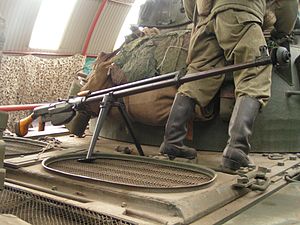PTRS-41
| PTRS-41 | |
|---|---|
 PTRS | |
| Type | Anti-tank rifle |
| Place of origin | |
| Service history | |
| In service | 1941 |
| Used by | Soviet Union, North Korea, China |
| Wars | World war II, Korean War, Chinese Civil War |
| Production history | |
| Designer | Sergei Gavrilovich Simonov |
| Designed | 1941-? |
| Produced | 1941–1945 |
| Variants | General specifications |
| Specifications | |
| Mass | 20.3 kg |
| Length | 2,000 mm |
| Barrel length | 1,219 mm |
| Crew | 2 |
| Cartridge | 14.5x114mm |
| Muzzle velocity | 1,013m/s (3,320 ft/s) |
| Effective firing range | 400 m |
| Maximum firing range | 800 m |
| Feed system | 5-round magazine |
The PTRS-41 is the semi-automatic cousin of the PTRD anti-tank rifle.
Design
The PTRS-41 was produced and used by the Soviet Union during World War II. In the years between the World Wars, the Soviet Union began experimenting with different types of armour-piercing anti-tank cartridges. Finding the 12.7x108mm insufficient, they began development of what would become the 14.5x114mm armor piercing round. Famous Soviet weapons designers such as Vasily Degtyaryov and Sergei Gavrilovich Simonov designed rifles to accommodate this cartridge. In 1938, Simonov designed the PTRS-41, a magazine fed, anti-tank rifle with a scaled down version of it becoming the SKS rifle.[citation needed]
The five round magazine was loaded into the receiver and held under pressure by a swing magazine underneath. On firing the last round the bolt is held open, and the magazine release catch can only be operated when the bolt is locked back. The gas operated PTRS has a tendency to jam when dirty, and the 14.5 mm cartridge produces significant residue, blocking the gas port. The 14.5 mm armour-piercing bullet has a muzzle velocity of 1012 m/s and good ballistics. It could penetrate an armour plate up to 40 mm thick at a distance of 100 meters.
History
The rifle entered mass production in 1941 and was widely used on the Eastern front in World War II. It performed well against early German tanks, and was also useful when attacking supply trucks and other soft-skinned vehicles. As tank armor got thicker and the rounds became insufficient to penetrate it, the Soviet anti-tank soldiers learned new tactics like shooting for vision ports, treads, and other "soft" parts that, if hit, could potentially disable the tank.
The 14.5 mm antitank rifles were put to a variety of other uses. Besides tanks and armoured vehicles, they were used to destroy mortars and machine gun emplacements.
During the war a number of these rifles were captured and used by the Germans. The rifles were given the designation Panzerbüchse 784(r) or PzB 784(r).
References
- [1]
- Koll, Christian (2009). Soviet Cannon - A Comprehensive Study of Soviet Arms and Ammunition in Calibres 12.7mm to 57mm. Austria: Koll. p. 91. ISBN 978-3-200-01445-9.
{{cite book}}: Cite has empty unknown parameter:|coauthors=(help)
